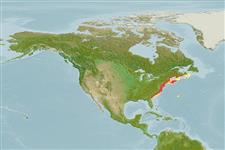>
Eupercaria/misc (Various families in series Eupercaria) >
Labridae (Wrasses)
Etymology: Tautoga: Plural of the word "taut", an Indian Brazil name translated by Roger William from f the Narragansett, "tautauog" = sheepshead.
More on author: Linnaeus.
Environment: milieu / climate zone / depth range / distribution range
Ecologia
marinhas; estuarina associadas(os) a recifes; intervalo de profundidade 1 - 75 m. Subtropical; 46°N - 31°N, 81°W - 58°W
Western Atlantic: slightly east of Halifax in Nova Scotia, Canada to South Carolina in USA; most abundant between Cape Cod and Delaware Bay.
Comprimento de primeira maturação / Tamanho / Peso / Idade
Maturity: Lm 23.6, range 18 - 26.5 cm
Max length : 91.0 cm TL macho/indeterminado; (Ref. 7251); peso máx. publicado: 11.3 kg (Ref. 40637); idade máx. registrada: 34 anos (Ref. 6486)
Descrição suscinta
Chaves de identificação | Morfologia | Morfometria
Espinhos dorsais (total) : 16 - 17; Raios dorsais (total) : 10; Espinhos anais: 3; Raios anais : 7 - 8. Distinguished from Tautogolabrus adspersus which occurs in the same area and further north, by its steep, rounded dorsal head profile; stouter body; scaled lower gill cover; and the more backward location of the pelvic fins.
Found close to shore on hard-bottom habitats, occasionally entering brackish water. Adult male territorial and active during the day to feed and rests in crevices at night. Prefers temperatures above 10°C. Spawning was noted in June-July in Canadian waters, but appears more protracted (April-July) in coastal waters of Virginia, USA. Feeds mainly on mussels, gastropods, other mollusks and crustaceans. This species has gained popularity as a prized food and sport fish (Ref. 6486, 4926, 41297). Investigation on the diel and seasonal activity patterns of the adult tautog in its southern range were conducted using ultrasonic telemetry (Ref. 41297).
Spawns in groups or in pairs. Pairing occurs between females and size-dominant males exhibiting strong territoriality and performing a protracted courtship (Ref. 6488). Gonochorism is confirmed for this species (Ref. 103751).
Leim, A.H. and W.B. Scott, 1966. Fishes of the Atlantic coast of Canada. Bull. Fish. Res. Board Can. (155):485 p. (Ref. 4926)
Status na Lista Vermelha da UICN (Ref. 130435)
Ameaça para os humanos
Harmless
Uso pelos humanos
Pescarias: pouco comercial; peixe esportivo: sim; Aquário: Aquários públicos
Ferramentas
Relatórios especiais
Baixar XML
Fontes da internet
Estimates based on models
Preferred temperature (Ref.
123201): 5.3 - 22.8, mean 10.9 °C (based on 96 cells).
Índice de diversidade filogenética (Ref.
82804): PD
50 = 1.0000 [Uniqueness, from 0.5 = low to 2.0 = high].
Bayesian length-weight: a=0.01230 (0.00803 - 0.01884), b=3.05 (2.93 - 3.17), in cm total length, based on LWR estimates for this species & (Sub)family-body (Ref.
93245).
Nível Trófico (Ref.
69278): 3.3 ±0.47 se; based on food items.
Resiliência (Ref.
120179): Baixo, tempo mínimo de duplicação da população 4,5 - 14 anos (K=0.09; tm=2-3; tmax=34).
Fishing Vulnerability (Ref.
59153): High to very high vulnerability (69 of 100).
Climate Vulnerability (Ref.
125649): Moderate to high vulnerability (55 of 100).
Nutrients (Ref.
124155): Calcium = 16.1 [7.1, 31.7] mg/100g; Iron = 0.447 [0.241, 0.886] mg/100g; Protein = 19.5 [16.6, 21.7] %; Omega3 = 0.193 [0.107, 0.343] g/100g; Selenium = 18.8 [9.2, 37.9] μg/100g; VitaminA = 39.3 [11.0, 166.7] μg/100g; Zinc = 0.912 [0.612, 1.593] mg/100g (wet weight);
